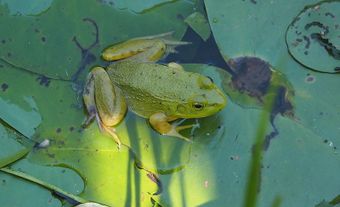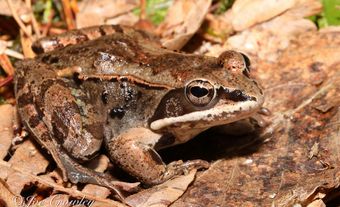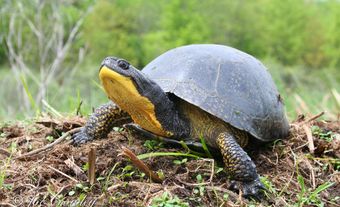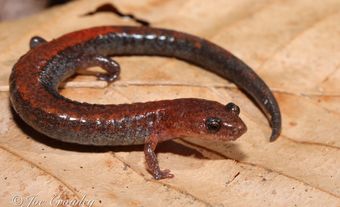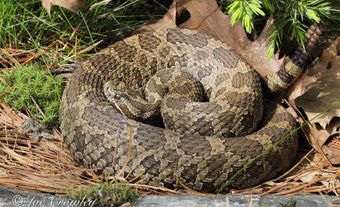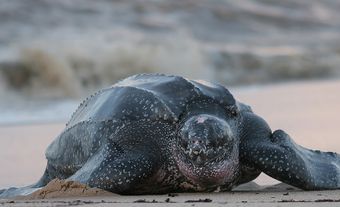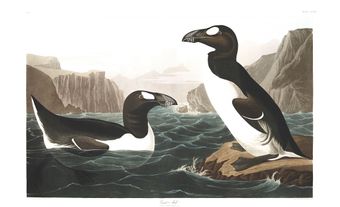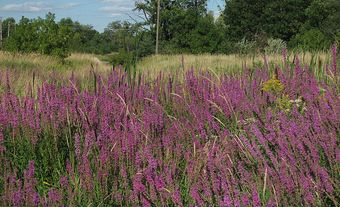The Fowler’s toad (Anaxyrus fowleri) is a medium-sized, earthen-coloured toad that is native to Eastern North America. In Canada, Fowler’s toads are only found in a few small areas along the north shore of Lake Erie. This species lives in places with sandy or gravelly soils into which individuals can burrow; Fowler’s toads spend much of their time underground. Due to small and declining populations, the Fowler’s toad is endangered in Canada.

Description
Adult Fowler’s toads are typically between 4.5 and 8.2 cm in length. They are usually grey to light brown on the back and sides, but some individuals may be reddish brown, greenish grey, dark grey or brown. They have darker brown spots on their back and sides that normally contain more than two small, wart-like bumps. Their underside is solid white or cream-coloured with little-to-no patterning, but there is sometimes a single dark spot between the forelimbs. Adult males have a dark-coloured throat. Like other toads, Fowler’s toads have granular skin with small wart-like bumps, cranial crests (bony ridges on the head between the eyes) and parotoid glands (large, oval-shaped, poison-producing sacs behind the eyes). Fowler’s toads sometimes hybridize with American toads, which can make identification challenging in areas where both species occur. Tadpoles are dark brown to black with increasing amounts of brown, brass or gold flecks or mottling as they age. The tadpoles reach a maximum length of less than 3 cm.
Distribution and Habitat
In Canada, Fowler’s toads are only found in three disjunct areas along the north shore of Lake Erie: the Niagara Peninsula, Long Point, and Rondeau Provincial Park (and adjacent Erieau). Historically, this species had a wider Canadian distribution, with populations at Point Pelee and on Pelee Island. Fowler’s toads have an extensive range in the Eastern United States that extends from southern New Hampshire and southeastern Vermont, south to the Florida panhandle and as far west as Iowa, Eastern Kansas, Arkansas and Louisiana.
Fowler’s toads live in areas with well-drained, sandy or gravelly soils, including sand dunes, beaches, shorelines of lakes and rivers and sandy deciduous woodlands. In Canada, this species is strongly associated with the Lake Erie shoreline, where individuals forage at night. During the day, the toads burrow into dunes or seek shelter under logs, vegetation, or other cover. Fowler’s toads breed in shallow, still water in temporary pools, ponds, wetlands and bays of lakes or rivers. During the winter, Fowler’s toads dig down into larger sand dunes where they can get below the frost line.
Did you know?
Like all toads, Fowler’s toads produce toxic secretions from their skin and parotoid glands. These secretions are distasteful or even harmful to many potential predators. However, some snakes, such as Eastern hog-nosed snakes, common gartersnakes and Northern watersnakes, have considerable tolerance to the toad’s toxins and are major predators of Fowler’s toads.
Reproduction and Development
In Canada, Fowler’s toads typically emerge from hibernation in early to late May. Breeding occurs over a few weeks in May or June. The call of breeding males is a rapidly pulsing trill that lasts for between two and five seconds. The trill produces a “waaaaah” sound that has been described as a wailing or droning scream. The female typically lays between 2,000 to 10,000 eggs, usually in two jelly-like strings that can be several metres in length. As with most frogs and toads, the male fertilizes the eggs as they are being laid. Fowler’s toad eggs are 1.0–1.5 mm in diameter and are black on top and tan or yellow on the bottom. The eggs develop quickly and hatch within one week or less. The aquatic larvae undergo metamorphosis and transform into terrestrial juveniles after approximately three weeks to two months. Fowler’s toads reach maturity at one to three years of age, and they can live for up to five years.
Diet and Predation
Fowler’s toads are usually active at night, but they may also be active on cloudy or rainy days. Adults are sit-and-wait predators, meaning that they remain still and wait for their prey to approach them. Fowler’s toads primarily eat insects, particularly ants and beetles, but they will also consume a variety of other invertebrates, such as spiders, worms and molluscs. Tadpoles feed on dead plant and animal material along the bottom of their aquatic habitat. Fowler’s toads are well-camouflaged and will remain still to avoid detection when approached by a potential predator. Snakes are the main predators of Fowler’s toads. Other predators include mammals such as racoons and skunks, birds, fish, turtles and American bullfrogs.

Threats
The destruction of beach and dune habitat due to residential, cottage and recreational development is a serious threat to Canada’s Fowler’s toad populations. Shoreline stabilization, such as the creation of break walls, also results in the loss and fragmentation of their beach and dune habitats. Beach raking, grading and other “beach cleaning” activities occur at many private and public beaches; these activities not only damage the habitat but also pose a serious risk to individuals below the surface. Non-native, invasive plant species are another serious threat to the Fowler’s toad in Canada; the European common reed (Phragmites australis) is the most prominent and has spread rapidly across Southern Ontario. It invades shallow-water habitats and forms dense stands that reduce biodiversity and lower water levels. This reduces the availability of breeding habitat for Fowler’s toads and has contributed to sharp population declines, particularly in the Long Point area. Severe storm events, which are increasing in frequency and severity due to climate change, can reduce the availability of beach habitat through erosion. In addition to these threats, Canada’s Fowler’s toad populations are small and isolated, which make them particularly susceptible to local extirpation.
Status and Conservation
Globally, the Fowler’s toad is listed as least concern by the International Union for Conservation of Nature. However, small and declining Canadian populations put Fowler’s toads at risk of disappearing from Canada. This species is listed as endangered under Canada’s Species at Risk Act. Concerted efforts to protect this species’ remaining habitat, as well as manage and mitigate other major threats, are required to recover Canada’s Fowler’s toad populations. For example, conservation efforts beginning in 2013 to restore breeding habitat and control phragmites at Long Point have been important in helping to halt the steep population decline in that region.

 Share on Facebook
Share on Facebook Share on X
Share on X Share by Email
Share by Email Share on Google Classroom
Share on Google Classroom
